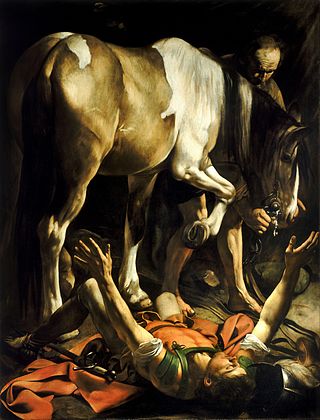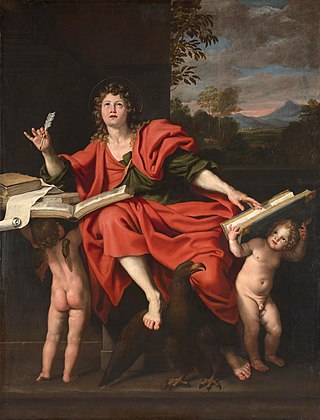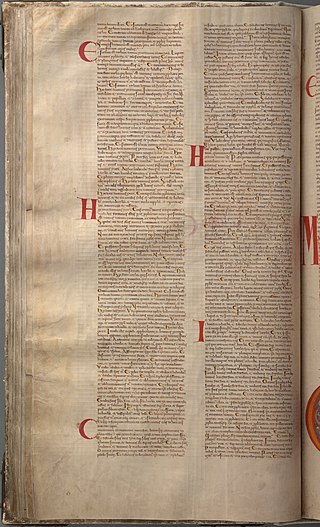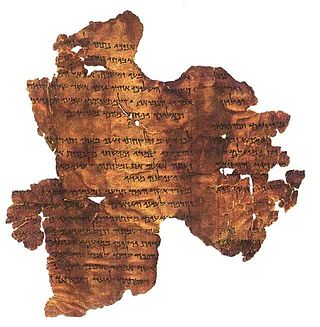
The Epistle to the Colossians is the twelfth book of the New Testament. It was written, according to the text, by Paul the Apostle and Timothy, and addressed to the church in Colossae, a small Phrygian city near Laodicea and approximately 100 miles (160 km) from Ephesus in Asia Minor.

The First Epistle of John is the first of the Johannine epistles of the New Testament, and the fourth of the catholic epistles. There is no scholarly consensus as to the authorship of the Johannine works. The author of the First Epistle is termed John the Evangelist, who most modern scholars believe is not the same as John the Apostle. Most scholars believe the three Johannine epistles have the same author, but there is no consensus if this was also the author of the Gospel of John.
The oldest surviving Hebrew Bible manuscripts—including the Dead Sea Scrolls—date to about the 2nd century BCE (fragmentary) and some are stored at the Shrine of the Book in Jerusalem. The oldest extant complete text survives in a Greek translation called the Septuagint, dating to the 4th century CE. The oldest extant manuscripts of the vocalized Masoretic Text, date to the 9th century CE.

Raymond Edward Brown was an American Sulpician priest and prominent biblical scholar. He was a specialist on the hypothetical Johannine community, which he speculated contributed to the authorship of the Gospel of John, and he also wrote studies on the birth and death of Jesus.

John 3:16 is the sixteenth verse in the third chapter of the Gospel of John, one of the four gospels in the New Testament. It is deemed one of the most popular verses from the Bible and is a summary of one of Christianity's central doctrines; the relationship between the Father (God) and the Son of God (Jesus). Particularly famous among evangelical Protestants, the verse has been frequently referenced by the Christian media and figures.

The pastoral epistles are a group of three books of the canonical New Testament: the First Epistle to Timothy, the Second Epistle to Timothy, and the Epistle to Titus. They are presented as letters from Paul the Apostle to Timothy and to Titus. They are generally discussed as a group and are given the title pastoral because they are addressed to individuals with pastoral oversight of churches and discuss issues of Christian living, doctrine and leadership. The term "pastorals" was popularized in 1703 by D. N. Berdot and in 1726 by Paul Anton. Alternate nomenclature for the cluster of three letters has been proposed: "Corpus Pastorale," meant to highlight the intentional forgery of the letters as a three-part corpus, and "Letters to Timothy and Titus," meant to emphasize the individuality of the letters.

Joseph Augustine Fitzmyer was an American Catholic priest and scholar who taught at several American and British universities He was a member of the Society of Jesus (Jesuits).

Luke 1 is the first chapter of the Gospel of Luke in the New Testament of the Christian Bible. With 80 verses, it is one of the longest chapters in the New Testament. This chapter describes the birth of John the Baptist and the events leading up to the birth of Jesus. Two canticles, the canticle of Mary and the canticle of Zechariah are both contained within this chapter. The unnamed author of Luke names its recipient, Theophilus, who is most likely a real person, but the term could simply mean a fellow believer, since theophilus is Greek for God lover. Early Christian tradition uniformly affirms that Luke composed this Gospel as well as the Acts of the Apostles, the companion volume to Luke, which is addressed to Theophilus in the same way. The title "The Gospel of Luke", found in many Bibles and some manuscripts, was added later with no indication that it was originally part of the text.
Divino afflante Spiritu is a papal encyclical letter issued by Pope Pius XII on 30 September 1943 calling for new translations of the Bible into vernacular languages using the original languages as a source instead of the Latin Vulgate.
Daniel 8 is the eighth chapter of the Book of Daniel. It tells of Daniel's vision of a two-horned ram destroyed by a one-horned goat, followed by the history of the "little horn", which is Daniel's code-word for the Greek king Antiochus IV Epiphanes.

Benedict Thomas Viviano a New Testament scholar and author, was a member of the Chicago Province of the Dominican Order of the Roman Catholic Church. He was on the faculty of the University of Fribourg, Switzerland, as a full professor of New Testament, teaching in the French language. Before teaching in Fribourg, he taught for 11 years at the Ecole Biblique in Jerusalem, and 12 years at Aquinas Institute of Theology in St. Louis. He was vice president of the Tantur Ecumenical Institute for Theological Studies in Jerusalem.
Anthony Raymond Ceresko (1942–2005) was an Old Testament scholar.
Pheme Perkins is a Professor of Theology at Boston College, where she has been teaching since 1972. She is a nationally recognized expert on the Greco-Roman cultural setting of early Christianity, as well as the Pauline Epistles and Gnosticism.
This is a timeline of the development of prophecy among the Jews in Judaism. All dates are given according to the Common Era, not the Hebrew calendar.
Roland Edmund Murphy was an American Catholic priest of the Carmelite order, a biblical scholar and a specialist in the study of the Old Testament. He was the George Washington Ivey Professor of Biblical Studies at Duke University.

Zechariah 4 is the fourth of the 14 chapters in the Book of Zechariah in the Hebrew Bible or the Old Testament of the Christian Bible. This book contains the prophecies attributed to the prophet Zechariah, and is a part of the Book of the Twelve Minor Prophets. This chapter is a part of a section consisting of Zechariah 1–8.

Zechariah 3 is the third of the 14 chapters in the Book of Zechariah in the Hebrew Bible or the Old Testament of the Christian Bible. This book contains the prophecies attributed to the prophet Zechariah, and is a part of the Book of the Twelve Minor Prophets. The chapter contains the vision of Joshua, the high priest, being cleansed before God. It is a part of a section consisting of Zechariah 1–8.

Zechariah 10 is the tenth of the 14 chapters in the Book of Zechariah in the Hebrew Bible or the Old Testament of the Christian Bible. This book contains the prophecies attributed to the prophet Zechariah, and is a part of the Book of the Twelve Minor Prophets. This chapter is a part of a section consisting of Zechariah 9–14.

Hosea 4 is the fourth chapter of the Book of Hosea in the Hebrew Bible or the Old Testament of the Christian Bible. This book contains the prophecies attributed to the prophet Hosea son of Beeri. In this chapter he reproves the people and priests for their sins in the interregnum following Jeroboam's death; hence there is no mention of the king or his family; and in Hosea 4:2 bloodshed and other evils usual in a civil war are specified. It is a part of the Book of the Twelve Minor Prophets.










